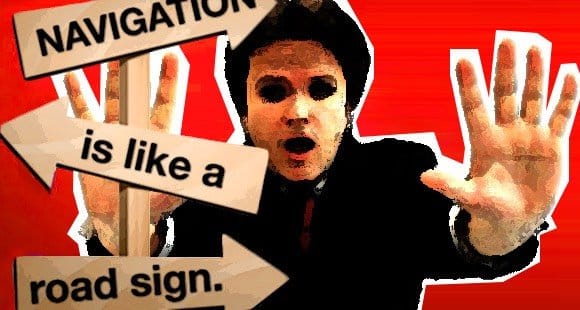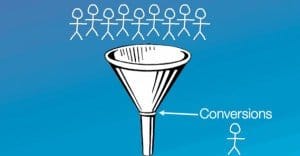3 Reasons Your Website Traffic Isn’t Converting Into Customers

At the end of the day, it’s all about the conversions. You could have a billion visitors to your site every day, but if none of them care about your product and they don’t buy anything, you get nothing. Well, you get an obscenely high bandwidth bill and probably a Guinness World Record, but those don’t help your business.
If your website isn’t converting, you need to find out why, and fast. There are hundreds of points of potential failure, but they boil down to three things. Let’s investigate those three things and figure out where your problem may be.
1. Traffic
The first possible point of failure is the people coming in to your site. Are they the kinds of people who care about your product? Do they distrust you? Do they have another issue you can diagnose and fix?
Your traffic is too unfocused to convert at any reasonable rate. Again, a billion daily visitors are worthless if they run the gamut in every demographic. It’d be much better to pull in 10,000 visitors, highly targeted and interested, when every one of them is interested in converting. Facebook is your friend for learning this information; make heavy use of Insights and PPC targeting experiments.
You’re targeting the wrong demographics. A site dedicated to gifts for men probably isn’t going to benefit from targeting pre-teen girls. At least, it won’t outside of Father’s Day. Picking the right demographics for your target audience is important, and it relies on you being aware of the types of people who are interested in using your product.
You’re not bringing in a sizable volume of traffic. Maybe your traffic is converting just fine, but you’re not bringing in enough of it. It could be a targeting issue, it could be an issue with broken ads, it could be any number of things. Check out the common culprits and see if you can identify ways to bring in more people.
You don’t have a connection with your readers. The emotional connection is where social media comes in. Your whole goal is to build yourself up as a trustworthy brand, a source of valuable information and insight. You do this by being human, not corporate. You put on a public face and you let your personality shine through. Build up that connection through comment responses and reactivity.
2. Site
If the people coming to your site aren’t the problem, maybe the site they’re landing on is. Much has been said about optimizing landing pages, but what about the rest of your site?
Your site design is unprofessional or out of date. Geocities may be gone now, but some amateur Internet businesses sure seem like they’re trying to keep the style alive. The problem is, the less professional a site looks, the more it looks like a scam to the typical Internet user. You need a slick, professional site if you want to convert. Make sure to focus group your designs; you don’t want to accidentally imitate a common scam layout.
You’re not publishing enough content regularly. The Internet, free form as it may be, thrives on schedules. We’ve been engrained as a culture to operate on a schedule, be it the 9-5 daily grind or the prime time television network blocks. Publishing content regularly will do more for you than publishing large batches whenever you feel like writing.
Your content is too promotional. The Internet is very resistant to hard sale techniques. They’re a huge turn-off for the average user. Instead, you need to build a reputation as a trustworthy business with a side order of “by the way here’s my product.” Give users a reason to trust you, a reason to want to buy from you, and then provide them the opportunity to buy.
You’re not being promotional enough. This is the opposite of the previous problem. So you run an excellent blog on a well-designed site; so what? If your user doesn’t realize you actually have a product to sell, they’ll never buy. Don’t be shy of the marketing part of Internet marketing; your users won’t be turned away by a button in your navigation bar, a sidebar ad or a bottom-line opt-in.
You can’t sell to mobile users. A mobile site is useful for just about any business. Even businesses that operate online only can benefit from being accessible to mobile browsers. If you don’t have a mobile version of your site, you’re just doing yourself a disservice. If you’re a local business, you would do less damage by literally shooting yourself in the foot. A mobile site attracts a massive amount of traffic simply by making your business available to people searching via mobile device.
3. Product
Finally, there are issues with your product. Pulling in a ton of traffic to a well-designed site is great, but if all you’re selling is a gold-plated roll of toilet paper, you’re not going to ship a unit.
No one wants to buy what you’re selling. Sometimes, you just don’t have a winning idea. This happens more often in the world of content, when you’re trying to sell ebooks or some other form of “cheap” product. When you’re offering a physical product requiring manufacturing and shipping, ideally you’ll have discovered the demand is missing well before you’ve set up an entire business around selling it.
You have no free samples. We live in a culture of free content with a try before you buy mentality. Some products, sure, it’s impractical to give a sample. You can’t sell TVs by giving out free TVs. What you can do, though, is offer a money back guaranteed on that TV. They buy it, they like it, they keep it and you have a conversion. They don’t like it, they ship it back, and you’re out the cost of shipping. With digital products, a free trial or a free ebook – a preview of your content – can be great incentives.
You’ve given your users no urgent reason to buy. Many users prefer to make a purchase when there’s a limited quantity available or some other looming deadline. If there’s no reason to buy right now, they’ll put it off. Then they’ll keep putting it off, again and again, until they’ve forgotten they ever wanted to buy in the first place. To combat this, give users an urgent reason to buy. Give them time-sensitive coupons or offers. Show them that you have a limited number of products you can sell. The pressure of an implied time limit is incredibly valuable.

 ContentPowered.com
ContentPowered.com







